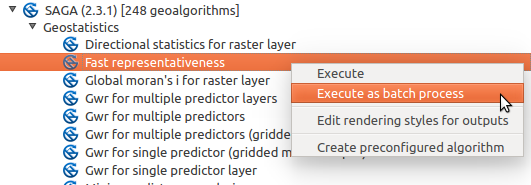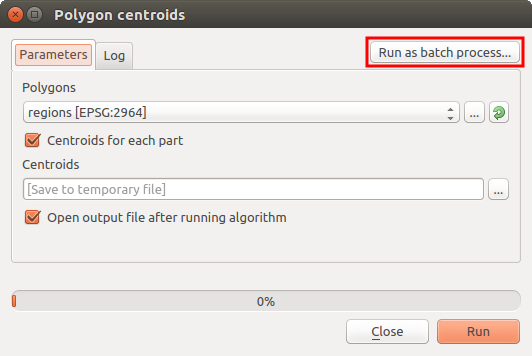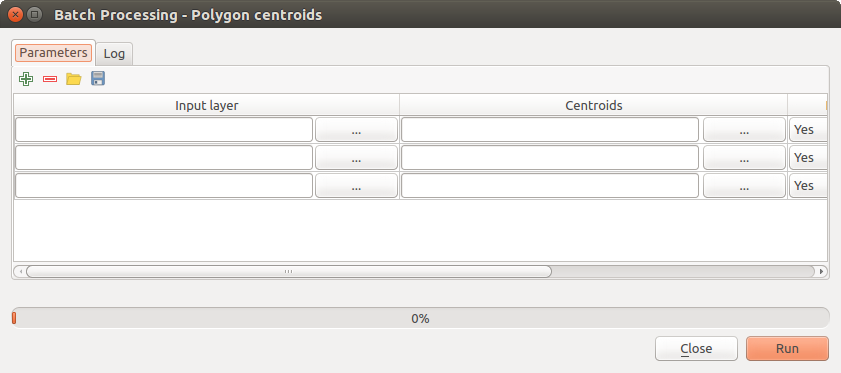23.6. A interface de processamento em lote
23.6.1. Introdução
All algorithms (including models) can be executed as a batch process. That is, they can be executed using not just a single set of inputs, but several of them, executing the algorithm as many times as needed. This is useful when processing large amounts of data, since it is not necessary to launch the algorithm many times from the toolbox.
Para executar um algoritmo como um processamento em lote, clique com o direito do mouse na caixa de ferramentas e selecione a opção Executar como processamento em lote no balão de opções que irá aparecer.

Fig. 23.29 Batch Processing from right-click
If you have the execution dialog of the algorithm open, you can also start the batch processing interface from there, clicking on the Run as batch process… button.

Fig. 23.30 Batch Processing From Algorithm Dialog
23.6.2. Os parâmetros da tabela
A execução de um processamento em lote é semelhante à execução única de um algoritmo. Os valores do parâmetro têm de ser definidos, mas neste caso nós necessitamos um conjunto de parâmetros, uma para cada vez que o algoritmo é executado. Os valores são introduzidos usando uma tabela como é mostrada a seguir.

Fig. 23.31 Batch Processing
Cada linha desta tabela representa uma única execução do algoritmo, e cada célula contém o valor de um dos parâmetros. É semelhante aos parâmetros do diálogo que vê quando executa o algoritmo a partir da caixa de ferramentas, mas com uma diferente disposição.
Por defeito, a tabela contém apenas duas linhas. Pode adicionar ou remover linhas usando os botões na parte inferior da janela.
Uma vez que o tamanho da tabela for configurado, terá de ser preenchido com os valores desejados.
23.6.3. Preenchendo os parâmetros da tabela
Para a maioria dos parâmetros, a configuração do valor é trivial. Basta digitar o valor ou selecioná-lo na lista de opções disponíveis, dependendo do tipo de parâmetro.
Filenames for input data objects are introduced directly typing or, more
conveniently, clicking on the … button on the right hand of the cell,
which will show a context menu with two option: one for selecting from the layers
currently opened and another to select from the filesystem. This second option,
when selected, shows a typical file chooser dialog. Multiple files can be
selected at once.
If the input parameter represents a single data object and several files are
selected, each one of them will be put in a separate row, adding new ones if
needed. If the parameter represents a multiple input, all the selected files
will be added to a single cell, separated by semicolons (;).
Layer identifiers can be directly typed in the parameter text box. You can enter the full path to a file or the name of a layer that is currently loaded in the current QGIS project. The name of the layer will be automatically resolved to its source path. Notice that, if several layers have the same name, this might cause unexpected results due to ambiguity.
Output data objects are always saved to a file and, unlike when executing an algorithm from the toolbox, saving to a temporary file or database is not permitted. You can type the name directly or use the file chooser dialog that appears when clicking on the accompanying button.
Um vez selecionado o arquivo, um novo diálogo será exibido para permitir que faça o auto-preenchimento das outras células na mesma coluna (o mesmo parâmetro).

Fig. 23.32 Salvar Processamento em Lote
Se o valor padrão (‘Não efetuar auto-preenchimento’) é selecionado, irá apenas por o nome do arquivo selecionado na célula selecionada da tabela de parâmetros. Se alguma das outras opções estiver selecionada, todas as células abaixo da selecionada irão automaticamente ser preenchidas baseando-se no critério definido. Desta forma, é mais fácil preencher a tabela, e o processamento em lote pode ser definido com menor esforço.
O preenchimento automático pode ser feito simplesmente adicionando números relativos ao caminho do arquivo selecionado, ou acrescentando o valor de outro campo na mesma linha. Isto é particularmente útil para nomear objetos de dados de saída de acordo com os de entrada.

Fig. 23.33 Batch Processing File Path
23.6.4. Executando o processo em lote
To execute the batch process once you have introduced all the necessary values, just click on OK. Progress of the global batch task will be shown in the progress bar in the lower part of the dialog.